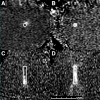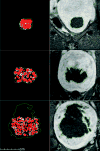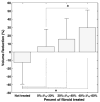Uterine leiomyomas: MR imaging-based thermometry and thermal dosimetry during focused ultrasound thermal ablation
- PMID: 16793983
- PMCID: PMC1850234
- DOI: 10.1148/radiol.2401050717
Uterine leiomyomas: MR imaging-based thermometry and thermal dosimetry during focused ultrasound thermal ablation
Abstract
Purpose: To retrospectively evaluate magnetic resonance (MR) imaging-based thermometry and thermal dosimetry during focused ultrasound treatments of uterine leiomyomas (ie, fibroids).
Materials and methods: All patients gave written informed consent for the focused ultrasound treatments and the current HIPAA-compliant retrospective study, both of which were institutional review board approved. Thermometry performed during the treatments of 64 fibroids in 50 women (mean age, 46.6 years +/- 4.5 [standard deviation]) was used to create thermal dose maps. The areas that reached dose values of 240 and 18 equivalent minutes at 43 degrees C were compared with the nonperfused regions measured on contrast material-enhanced MR images by using the Bland-Altman method. Volume changes in treated fibroids after 6 months were compared with volume changes in nontreated fibroids and with MR-based thermal dose estimates.
Results: While the thermal dose estimates were shown to have a clear relationship with resulting nonperfused regions, the nonperfused areas were, on average, larger than the dose estimates (means of 1.9 +/- 0.7 and 1.2 +/- 0.4 times as large for areas that reached 240- and 18-minute threshold dose values, respectively). Good correlation was observed for smaller treatment volumes at the lower dose threshold (mean ratio, 1.0 +/- 0.3), but for larger treatment volumes, the nonperfused region extended to locations within the fibroid that clearly were not heated. Variations in peak temperature increase were as large as a factor of two, both between patients and within individual treatments. On average, the fibroid volume reduction at 6 months increased as the ablated volume estimated by using the thermal dose increased.
Conclusion: Study results showed good correlation between thermal dose estimates and resulting nonperfused areas for smaller ablated volumes. For larger treatment volumes, nonperfused areas could extend within the fibroid to unheated areas.
RSNA, 2006
Figures






References
-
- Ishihara Y, Calderon A, Watanabe H, Okamoto K, Suzuki Y, Kuroda K. A precise and fast temperature mapping using water proton chemical shift. Magn Reson Med. 1995;34(6):814–823. - PubMed
-
- Hindman JC. Proton resonance shift of water in the gas and liquid states. J Chem Phys. 1966;44:4582–4592.
-
- Peters RD, Hinks RS, Henkelman RM. Ex vivo tissue-type independence in proton-resonance frequency shift MR thermometry. Magn Reson Med. 1998;40(3):454–459. - PubMed
-
- Kuroda K, Chung AH, Hynynen K, Jolesz FA. Calibration of water proton chemical shift with temperature for noninvasive temperature imaging during focused ultrasound surgery. J Magn Reson Imaging. 1998;8(1):175–181. - PubMed
-
- De Poorter J. Noninvasive MRI thermometry with the proton resonance frequency method: study of susceptibility effects. Magn Reson Med. 1995;34(3):359–367. - PubMed
Publication types
MeSH terms
Grants and funding
LinkOut - more resources
Full Text Sources
Medical

